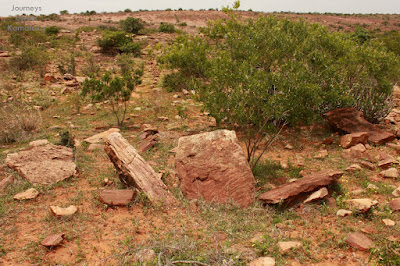Kutakanakeri is a village 8 km north of Badami town. It is situated at the base of a large sandstone formation, rather a sandstone hillock which happens to be a prehistoric site. In the sprawling sandstone formation are several natural shelters which had been inhabited thousands of years ago. The evidence for human inhabitance are paintings on rocks depicting humans, animals and fur patterns. Also among the paintings are an outline of a hand, and a creature like a human but having different features. Then there are megalithic graves, all of which have been disturbed by humans. During our short tour of Kutkankeri hillock guided by a local person we saw about 10 to 15 graves, not a single one of them were close to the original condition like the megalithic graves on Aihole hillock. Below are a few pictures of the remnants, at least some evidence had survived. Now i.e. 11 years after my visit. I hope they haven't been disturbed any more.
These sandstone slabs are rough rectangles measuring 5' x 5' approximately. The slabs are much longer considering the portion below ground level. These slabs are about 4" thick however thickness varies from grave to grave, there were slabs more than 6" thick like the one seen below. Our guide Fakirappa on the right and on the left is late Malatesh, a colleague then. There's a 4' x 4' slab flat on the ground in front of my friends and two partially buried slabs at an angle. As I remember, Fakirappa mentioned that they believe these to be graves of muslim people. Probably someone tried to dissuade vandals from disturbing the graves further.
The reason for disturbing the graves could be buried treasure. Ignorant people don't realize the historical value of these monuments. The damage is irreparable, archaeological evidence is lost forever.
A freshly dug put close to one of the graves, the slabs are strewn around. The vandals have dug a neat pit, almost a perfect square. It looks like the stone slabs had been much before the pit was dug. Treasure hunters try again and again hoping to find something valuable.
One more grave site. One might wonder how bodies were buried in these graves. Here's how: four slabs would be erected in a quadrilateral formation creating an open chamber. The corpse or corpses would be placed in the chamber and dirt would be poured to fill the empty space. Once the chamber is filled to the brim, a capstone would be placed over the vertical slabs sealing the tomb. This is a possible method, the burial process could be much more complex.
Three more large slabs. I'm assuming that these had never been fixed into the ground earlier. May be these slabs had been brought here to make a burial chamber and they weren't used at all.
One might also wonder about the source of these slabs. I'm certain that these slabs were obtained from this hill itself.
In some parts of the hill, there are layers which have almost separated from the hillock. This is one such example of bits which have been broken away.
This is another example with a number of bits which could be used to build smaller graves. Going by that assumption this spot could be a prehistoric quarry site. Certain stones form rifts naturally and separate over time due to temperature cycles. Sandstone is prone to such behavior making it easy to break away pieces. Also, sandstone being relatively softer, it can be shaped easily.




















No comments:
Post a Comment